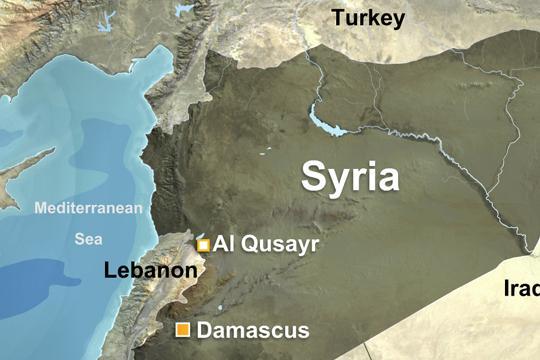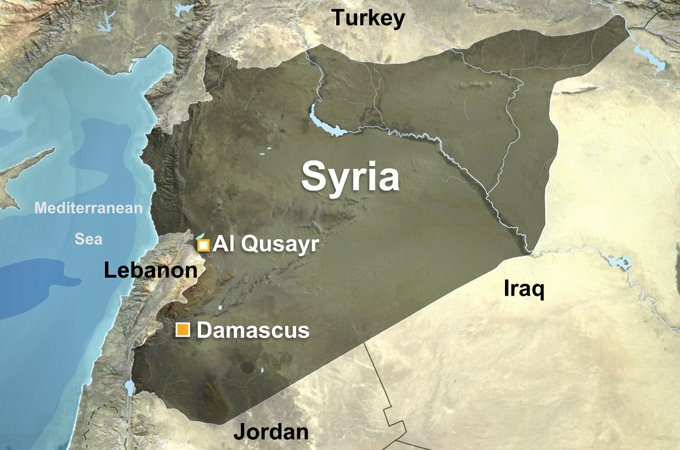
 |
In a speech on 30 April 2013, Hezbollah Secretary General Hassan Nasrallah emphasised that Hezbollah’s military involvement in the Syrian conflict reflects a strategic position that will not allow the fall of Bashar al-Assad’s regime.[1] This puts more burden on Hezbollah as a party that must restore its place in Lebanon and beyond as part of a strategy enabling it to adapt to the changes to which its deep Syrian and regional links have exposed it[2] as well as to maintain a permanent state of readiness for an expected war with Israel. Hezbollah has to face developments in Syria, which are to be responded to according to precise agreements that conform to major Iranian strategies in the Levant region.
The Battle of al-Qusayr: Background
Hezbollah had announced its reservations toward the Syrian revolution and its support for the Syrian regime alongside Iran, which it emphasised by defending the regime. Despite the growing size and strength of the Syrian opposition, Hezbollah has continued to support the regime militarily, fighting alongside it at various locations in Syria, especially to protect its revered shrines. Hezbollah also protected Shiite-majority areas, specifically on the border between the Lebanese region of Hermel and the Syrian countryside of al-Qusayr, as it is diffi cult for the Lebanese state to gain access to Syrian territory and protect these people and their property.
Fighting in the al-Qusayr countryside reached a climax in which Hezbollah dominated most of the Syrian villages to the west of the Orontes river. More of its members died than in previous clashes. The Syrian opposition estimates the number of Hezbollah deaths to be tens, while Hezbollah's previous Secretary General, Subhi al-Tufayli, stated after the battle that there were 138 dead,[3] indicating that the attack on al-Qusayr shows the party’s growing military role in this region. This matter demanded that Nasrallah make a public appearance at the end of April to clarify developments, although he was originally scheduled to appear on 9 May.[4]
The battle of al-Qusayr was linked to the deteriorating security conditions in Damascus as well as in most other areas along the Lebanese border. A likely scenario is that the safe geographic route between Lebanon and Syria will be closed off, thereby affecting the lines of coordination and logistics between Hezbollah and Damascus. This will weaken the link between Lebanon’s 8 March forces and al-Assad's regime. In this context, the battle of al-Qusayr can be seen, as stated by Hezbollah, as a "preventive measure" similar to that which occurred in Beirut on 7 May 2008 "to protect the resistance,"[5] i.e. Hezbollah, and regain the ability to inject hope in the 8 March forces, in which the Syrian regime is still a key player.[6]
A direct and important consequence of Hezbollah's latest entry into Syrian territory is the Syrian opposition’s wider mobilisation of Islamist groups in addition to other armed opposition groups in the face of Hezbollah's expansion in order to create militarily balance in that area in particular. The opposition also did this for the Syrian army in several areas of extreme conflict. Due to international pressure, the opposition has two choices: to enhance the influence of ‘extremist groups’ in Syria or take on military engagements on behalf of the Syrian people to lessen support for the causes of extremism. However, the main requirement is it to strengthen its armed resistance, because these groups, along with other Islamist movements, still represent the backbone of the opposition on more than one front and are the most stable in the field. One of the most prominent images of sectarian conflict in the region is thus bloody war between Sunni and Shiite Islamists. Furthermore, al-Qusayr will probably be the geographical region to which the western powers may turn a blind eye regarding the infiltration of the Al-Nusra Front and other similar groups vis-à-vis the intervention of Hezbollah, so that it becomes a battle between ‘terrorists.’
Lebanon and the Post-al-Qusayr Phase
The Lebanese government headed by Najib Mikati resigned on 22 March 2013.[7] A new government, headed by Tammam Salam, was formed and must now draw up a new electoral law that will satisfy all parties before the House of Representatives' legislative deadline on 19 May. If it fails to do so, the current parliament’s term will be extended. Such an extension may be subject to legal criticism; therefore concerns of a political vacuum are being voiced.
The battle of al-Qusayr in these circumstances seems pointless, but perhaps that is its objective. It seems as if the fall of Mikati’s government marks the fall of the last remaining "policy of self-isolation," which the former government had adopted as its slogan. This could result in Hezbollah and its allies' re-evaluation of the balance between their approach to Syrian affairs – which is essentially that Lebanese fighting alongside the Syrian regime is a national matter for the Lebanese and a vital issue in the "resistance" against Israel – and their current tolerance of the Lebanese that support the Syrian opposition militarily. It is thus required o f the other parties, in return, to understand Hezbollah's need for support via support for the Syrian regime and provide guarantees that it will form part of the new government. Otherwise, the government will stumble.
It is worth mentioning that Hezbollah's revelation of its escalating role in Syria came gradually. It previously denied direct involvement with events in Syria, and then admitted support for Lebanese Shiites in areas along the Syrian- Lebanese borders to defend and enable them to stay in their own land. Hezbollah later admitted to direct intervention and defence of Shiite religious shrines, and finally to supporting al-Assad. Hezbollah promoted sectarian enmity against the Syrian rebels by describing them as "terrorists" against Shiites. This contributed to the persuasion of masses to join it in the war, and possibly create a Shiite al-Qaeda as well as some elite units to promote its aims. It is very likely that this could be a prelude to a bigger military intervention in Syria because it is unlike Hezbollah to disseminate information about its activities in advance as this may render it more susceptible to confrontation, unless it deliberately wishes to escalate matters.
In contrast, calls came from Ahmed al-Assir, a captive in the southern city of Sidon, and Salem al-Rafii in Tripoli to "support the resistance" in al-Qusayr and volunteer against the "attacks carried out by Hezbollah" and the Syrian army against the Syrian people. These sheikhs and al-Assir’s supporters adopted and modified Hezbollah's argument, claiming that they were seeking "to protect the Lebanese in Syria and defend the holy sites, especially mosques that have been flattened to the ground." They also distributed, as part of media escalation between the two parties, a video showing Al-Assir alongside fighters in al-Qusayr.
The position of the two sheikhs, who enjoy only limited support from Sunnis relative to the support Hezbollah has from the Shiite community, will result in minimal response regarding military support for the Syrian revolution. However, it may upset Hezbollah's call and create local obstacles in the face of Hezbollah's clear and public decision to intervene in the Syrian crisis. The position of the sheikhs has nevertheless received a warm welcome from Lebanese Sunnis as a "discourse of escalation." This may pave the way for the militarisation of the Sunni community in the medium term, especially if traditional Sunni forces cannot call for the suppression and confrontation of Hezbollah.
This scenario will reinforce sectarian strategies in Lebanon. The controversy over the Syrian revolution is not confined to doctrinal affairs but is also related to the political divide between 8 March forces and 14 March forces on a national basis. This will compound the division between the political and the sectarian and will mean that dealing with any political events in Lebanon, such as the formation of the government and the parliamentary elections, will need an agreement similar to the 2008 Doha agreement,[8] which subsequently failed due to the fall of Saad Hariri’s government on 12 January 2011. Lebanon has proven that since Syrian withdrawal from Lebanon, there is no guarantee to any agreement among the Lebanese due to lack of trust and local and regional overlaps in terms of membership and engagement.
Hezbollah's Regional Role
The escalation of international sanctions on Iran and the multiplicity of axes wanting to isolate it from the world, or the threat of attacks against it, made Tehran more conscious of its powerful allies and assets in the region: Iraq, Yemen, Syria and Lebanon. In this regard, it can be noted that Hezbollah's position since the 2006 war has become more consistent, in speeches and action, with Iran’s discourse and requirements in the region regardless of the justifications that it tries to give for issues of resistance against and confrontation of Israel and its allies.
The vulnerability of the Syria-Iran front (that Hezbollah belongs to) to blockade and a potential military strike requires Hezbollah to stick to its regional role, even at the expense of the Lebanese context or of engaging with its historical foes, Sunni Islamists. These reasons are understandable in the context of its make-up and sectarian identity. Flexibility – like that of Iran’s discourse and ability to reverse the dimensions of religious, Islamic and national issues in response to the challenges it faces – can easily stimulate the sectarian discourse and overlook Islamic and national bonds when necessary. Similarly, because Hezbollah built its "resistance" on a complex regional equation, the essence of which is drawn from a multi-dimensional Iranian perspective, it is based on ideologically dogmatic beliefs of velayat-e-faqih (governance of the religious jurist). In its geopolitical dimension, it seeks Iran’s dominance over others in the region, whether it is through "partnership" with the Arabs, such as its historical relationship with Syria, or without them, such as its often strained relationship with the Gulf states.
The Iranian-Syrian link, which is behind Hezbollah's alliance with al-Assad, will not necessarily remain as strong, especially as circumstances have changed since Tehran has room to manoeuvre. There is another Iranian viewpoint within the parameters of its traditional discourse that allows for the existence of a Syrian reformist opposition that believes that Iran is keen to stop Syrian blood from shedding so that no one drowns in a long-term civil war. This viewpoint holds that its doors are open for dialogue between the opposition and the regime in aims of finding a political solution. It hopes to establish, under this discourse, relations with various Syrian factions are that likely to be effective in the event that al-Assad's era ends. It would also be more receptive to forming alliances if needed.
The Iranian Supreme Leader, Ali Khamenei, has repeatedly stated that what is happening in Syria is a war on Iran itself and that the forces of resistance and the armed opposition are supported by Zionism, America and some Gulf countries. To settle the conflict, the strategic alliance in the current circumstances will therefore continue until all of Syria supports al-Assad.
The Iranian discourse's multiple context is regionally in unison with the battle of al-Qusayr. It is related to the discussion about the need to create a safe geographic area for al-Assad’s regime in case the situation in Damascus deteriorates or the government’s collapses. The region stretches between Homs and Latakia. It would thus be an Iranian and Syrian objective; and Hezbollah and the Shiite villages bordering the countryside of al-Qusayr, or perhaps west of the Orontes River, would be its main link because a weak link between Hezbollah's rear base in Hermel, its neighbouring area and the surrounding Syrian sprawl would create difficult logistical conditions for Hezbollah to overcome any developments, at least during this current stage as it may require a continued supply of weapons. This could be true especially in the event of a renewed military confrontation with Israel for any reason, or in the event that Iran faces a military strike that may require Hezbollah to be part of the comeback, as well as in the continuation of the Iranian-Syrian coalition forces in Lebanon, i.e. the 8 March forces.
Hezbollah's progress in the al-Qusayr countryside will secure it with a strong, albeit limited, Shiite base. Its progress will enhance its ability to engage and may provide it with mutual support from the Syrian regime should the conflict between the regime and the opposition stabilise to become a long drawn-out civil war. Hezbollah would then consolidate its political and logistical gains in Lebanon, and any divisions in Lebanon will be completely tied to divisions in Syria.
Progress in al-Qusayr also represents a response to the possible situation where the Lebanese-Syrian border area is subject to international forces, thus cutting the link between Lebanon and Syria, and between Hezbollah and its supporters. There are multiple possible scenarios that may have similar results but not necessarily similar causes, as was shown in the 2006 war with Israel when Hezbollah was driven out beyond the north of the Litani River.[9] Its expulsion, in this case, was far from the border with Syria.
Conclusions
All the possibilities that may result due to the Syrian crisis intersect with Hezbollah's need to accelerate its military repositioning in Lebanon to maintain its political standing with allies and its popular Shiite base, and focus on increasing its military stock in Lebanon and developing its military role in Syria in different ways. This is due to its confidence that the unrest in Syria will continue, whether al-Assad’s regime falls or survives; whether it builds a tiny state or resorts to a geographically safe area; and whether Syria remains united or is divided. Iraq is a witness of this analysis; despite being more coherent than the future Syria, it remains volatile and an open field for all parties.
There is one possibility that Hezbollah and Iran consider improbable. This is a scenario that limits their active role in Syria: the establishment of a new unified Syrian state, possibly through an international or regional agreement without the involvement of either Iran or Hezbollah. Hezbollah has repeatedly stated that the solution in Syria is a political one and that it will never abandon it, arguing that "it is necessary that we be part of the solution and its caretakers."
The battle of al-Qusayr set a new regional role for Hezbollah in Syria, which can be seen in the context of two military options. The first would be defensive in its confrontation of Israel and its appeal to Lebanese nationalism would not be concealed; the second is an offensive option with sectarian dimensions against the Syrian opposition and has Lebanese and regional dimensions.
This battle has added to Lebanon’s dilemma concerning Hezbollah's weapons. The legality of Hezbollah's weapons, after the battle of al-Qusayr, is no longer tied only to protecting Lebanon from Israeli aggression but also for the security of Lebanese people in Syria where it is difficult for the state to protect them. This can be seen in the Lebanese defence strategy put forward between the 8 March and 14 March forces.
Wherever they are directed, Hezbollah's military capabilities create new policies that will increase the difficulty of dialogue between the conflicting Lebanese parties. It will also increase links with the Lebanese crisis, especially if the concept of "protecting the resistance" expands to other crises in the re gion – from Syria through Iraq to Iran.
*Shafeeq Choucair is a researcher specialising in the Levant and Islamist movements.
[1]Hassan Nasrallah stated very clearly in his speech: "The regional and international friends of Syria will not allow it to fall into the hands of America, Israel or any groups declaring others to be disbelievers." His speech can be viewed at: http://www.youtube.com/watch?v=wGsGF0CJ5tE.
[2]Concerning the repositioning of Hezbollah in Lebanon and beyond, see: "Hezbollah’s Role in Syria and the Implications for Lebanon," 20 November 2012, Al Jazeera Center for Studies. http://studies.aljazeera.net/en/reports/2012/11/20121120114428938339.htm.
[3]Former Secretary General, Sheikh Sobhi al-Tufaili, who is at odds with Nasrallah, in a televised interview on 24 April 2013, stated that Hezbollah had lost 138 people in Syria. See http://www.youtube.com/watch?v=_ArI6SdQDJ8.
[4]Hezbollah's intermediaries announced beforehand that Nasrallah met Khamenei in Iran and that he would appear before an audience on 9 May to commemorate the establishment of Hezbollah's media tracking institution. See http://www.naharnet.com/stories/ar/80214.
[5]On 7 May 2008, Lebanon witnessed a wide military campaign through which Hezbollah dominated large parts of Beirut and its suburbs in order to protect its communications network and "the resistance."
[6]Bashar al-Assad met with a delegation representing Lebanese parties, specifically the 8 March forces, on 21 April 2013. This almost coincided with the military escalation in the suburbs of Damascus and al-Qusayr.
[7]Regarding the resignation of the Lebanese government, see http://www.aljazeera.net/news/pages/91809f9a-441a-4b51-a31b-5343527412c4.
[8]Accepted at a meeting held between 16 and 21 May 2008, the Doha agreement caused the 8 March and 14 March forces to elect a new president, military commander Michel Suleiman, calling for new parliamentary elections, and form a government headed by Saad Hariri. Agreement documents can be found at: http://www.qatarconferences.org/lebanon/.
[9]The July 2006 war ended through United Nations Security Council Resolution 1701, which provided for, in addition to the "end of combat operations," the withdrawal of Hezbollah's forces from the north of the Litani River and the deployment of the Lebanese army to that area.
Copyright © 2013, Al Jazeera Center for Studies, All rights reserved.
